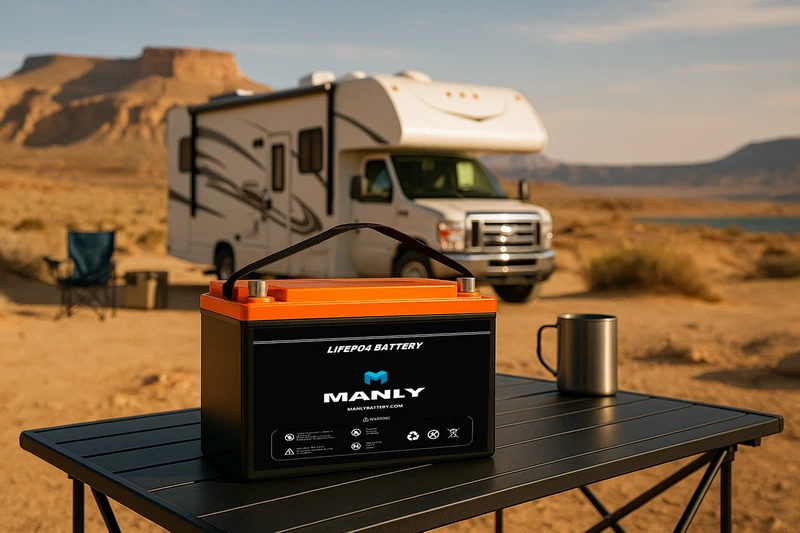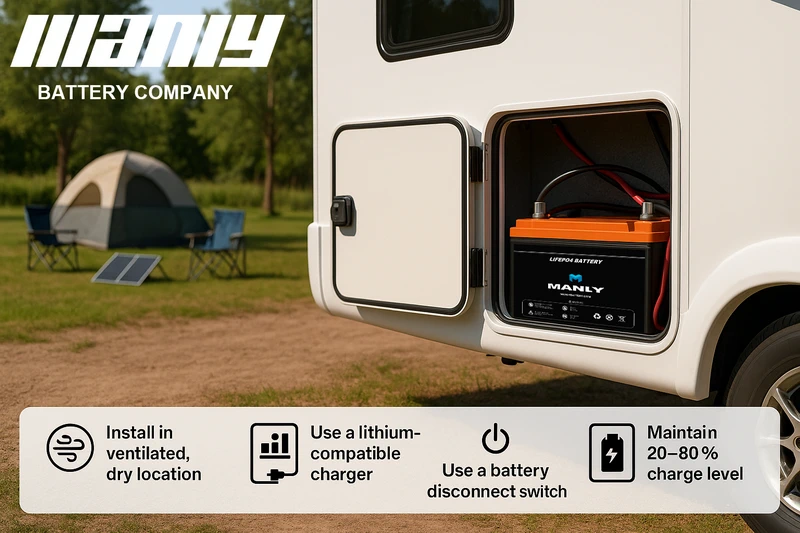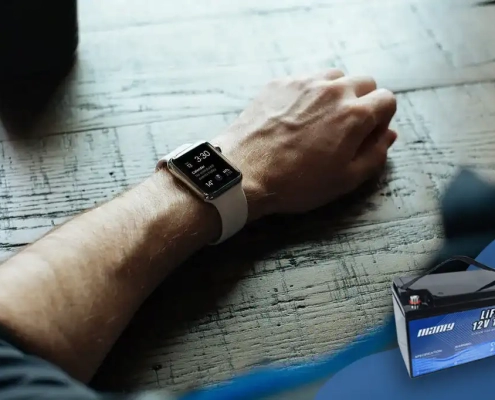2025 How Long Do Lithium RV Batteries Last?
Table of Contents
- 2025 How Long Do Lithium RV Batteries Last?
- Understanding Lithium RV Battery Lifespan
- How Do I Know if My Lithium RV Battery Needs Replacing?
- Tips for Extending the Life of Lithium RV Batteries
- Maximizing Your Lithium RV Battery Performance
- Upgrading Your RV Battery System to Lithium
- How to Find a Manufacturer for Lithium RV Batteries
- Conclusion
- FAQ
- Learn More About Battery
When it comes to powering your RV, few upgrades offer more value than switching to lithium RV batteries. Known for their long lifespan, fast charging, and low maintenance, these batteries have become the gold standard for off-grid travelers, full-time RVers, and solar-powered systems. But understanding how long they actually last—and what affects that lifespan—can help you make smarter decisions about maintenance, replacement, and who you trust as your battery manufacturer. Whether you’re upgrading your existing setup or looking to find a manufacturer for bulk supply, this guide breaks down everything you need to know to maximize performance and plan ahead with confidence.
Understanding Lithium RV Battery Lifespan
For RV owners who rely on off-grid power, understanding the true lifespan of lithium RV batteries is more than a curiosity—it’s essential for long-term planning. Unlike older battery types that may last just a few years, high-quality lithium batteries, especially LiFePO₄, offer serious durability. If you’re living full-time in an RV or planning long trips away from hookups, knowing how long your battery will last helps you budget smarter and avoid unexpected power failures on the road.
Let’s break it down.
1. Why Lithium RV Batteries Outlast the Rest
Most lithium RV batteries—specifically lithium iron phosphate (LiFePO₄)—can deliver 10 to 15 years of dependable service. That number isn’t pulled out of thin air. It’s based on real-world testing and performance benchmarks across the RV and energy storage industries.
These batteries typically support 2000 to 5000 charge cycles, depending on how deep you discharge them and how often. For weekend campers, that could mean over a decade of use. For full-timers, it still translates to many years before you need a replacement.
By contrast, lead-acid and AGM batteries may only last 3 to 6 years and require far more maintenance. You’ll also need to replace them multiple times during the life of one lithium RV battery.
2. What Affects Battery Lifespan?
Battery life isn’t just about the chemistry. Several key factors directly affect how long your lithium power bank will hold up:
2.1. Depth of Discharge (DoD)
LiFePO₄ batteries allow deep discharges—up to 80–90%, safely. But shallower discharges (around 50–70%) can increase lifespan. Avoid draining to 0% when possible.
2.2. Charge Cycle Quality
Using a compatible charger and avoiding overcharging is critical. Cheap chargers that lack smart features can shorten battery life. Look for models from a reputable battery manufacturer, especially ones tested for 12V LiFePO₄.
2.3. Temperature Conditions
Extreme heat or cold accelerates battery degradation. For best performance, keep your battery in a range between 32°F–113°F (0–45°C). Some advanced batteries include internal heating elements to stay operational in freezing weather.
2.4. Storage Habits
When not in use for extended periods, store your lithium battery at around 50–60% state of charge, ideally indoors in a cool, dry place. Doing so reduces internal stress and chemical wear.
2.5. Manufacturer Quality
Not all lithium batteries are built to the same standard. Choosing a proven battery manufacturer—ideally from a China battery factory with a strong track record in exports—ensures consistency and quality. For example, MANLY Battery is a known China 12V LiFePO₄ lithium battery factory, producing long-cycle batteries that meet strict international certifications like UL and UN38.3.
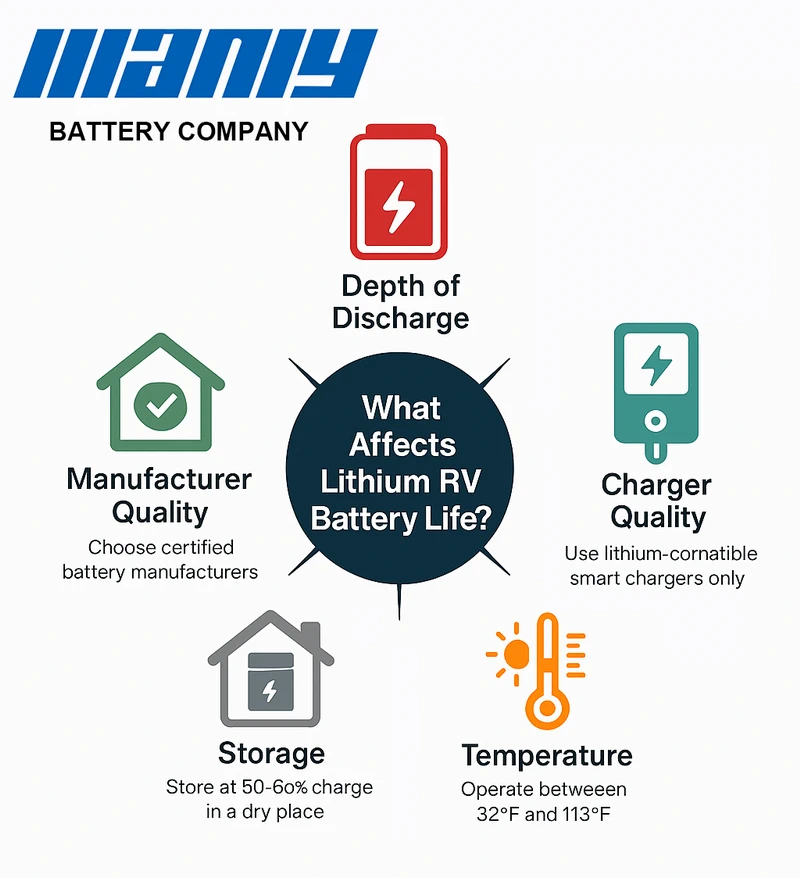
How Do I Know if My Lithium RV Battery Needs Replacing?
If you depend on lithium RV batteries to power your off-grid travel, knowing when it’s time for a replacement is critical. Even top-tier LiFePO₄ batteries—often supplied by a trusted battery manufacturer—have a finite lifespan. Miss the warning signs, and you could end up stuck without power in the middle of your trip.
This section walks you through the most common symptoms of a failing lithium battery, what they mean, and what to do about them—so you can stay ahead of costly downtime and avoid damage to your RV’s power system.
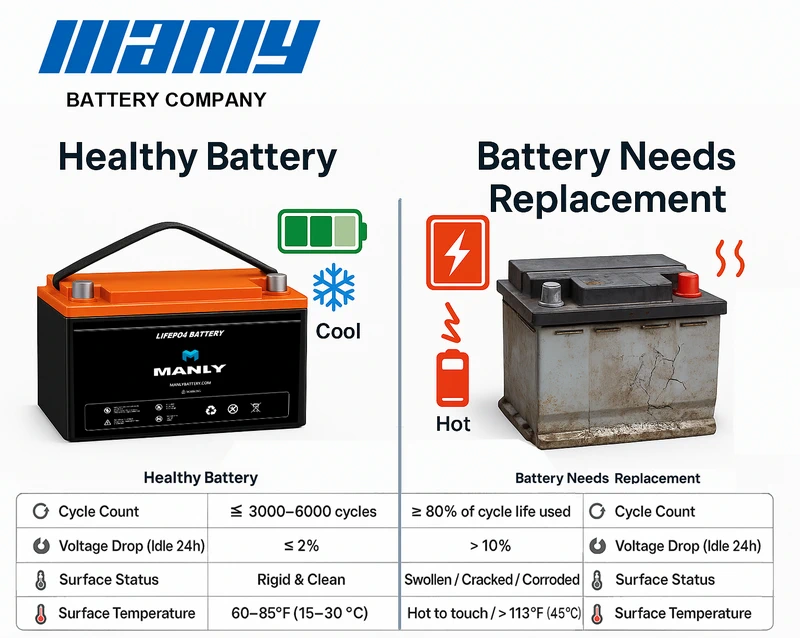
1. Battery Age and Performance Drop
Every battery has a cycle limit. For lithium RV batteries, that typically means 2,000 to 5,000 charge cycles or about 8 to 15 years, depending on how you use and store them.
If your battery is more than 8 years old, or you’re noticing shorter run times between charges, it could be nearing the end of its usable life. Use a Bluetooth-enabled battery monitor or a smart BMS (Battery Management System) to track voltage, state of charge, and cycle count. A visible decline in performance over time is your cue to start planning for a replacement.
2. Corrosion or Swelling
Unlike lead-acid models, LiFePO₄ batteries don’t corrode easily. But that doesn’t mean they’re immune to visible wear. Swelling or bulging of the battery case is a serious red flag. It often signals internal gas buildup from overheating or overcharging—both of which compromise safety.
If you notice your battery case expanding, warping, or cracking, stop using it immediately. Physical distortion can indicate damaged cells or thermal stress. Corrosion near the terminals, while rare in lithium chemistries, may appear if the seals are damaged or if the battery was exposed to salt air or excess moisture. Either issue warrants replacement.
3. Short Runtime After Charging
Fully charged batteries should deliver consistent power. If your battery drops from 100% to under 50% within just a few hours—without any major loads—it likely has diminished capacity.
Try isolating the issue: disconnect all appliances, charge the battery to full, then leave it idle for 12–24 hours. If voltage drops significantly (e.g., from 13.4V to under 12.8V), the cells are no longer holding energy effectively. This symptom often occurs in older batteries or ones exposed to repeated deep discharges beyond the 80–90% recommended threshold.
4. Battery Won’t Hold a Charge
A lithium battery that fails to hold a charge even after a full cycle is likely at the end of its service life. You’ll see this when:
Your solar controller reports 100% charge, but the voltage drops quickly.
The inverter shuts down earlier than expected.
The battery takes far longer to charge than it used to.
This issue may stem from cell imbalance or degradation of the internal chemistry. If you’ve already ruled out faulty wiring or inverter issues, replacing the battery is your best course of action.
5. Unusual Smell or Heat
Lithium RV batteries are prized for their thermal stability, especially LiFePO₄ types. But if you detect a chemical smell, burning odor, or if the battery becomes hot to the touch while idle, treat it as an emergency.
This could signal a short circuit, failed BMS, or internal breakdown. Immediately isolate the battery and disconnect it from all power sources. Continued use in this condition can lead to fire or permanent damage to your RV’s electrical system.
For long-term safety and performance, always source your batteries from a certified battery manufacturer or verified China battery factory with international certifications like UL, CE, or UN38.3. You can also use manufacturer data to compare safe temperature ranges and overcurrent protections when you find a manufacturer for new units.
| Indicator | Normal Range | Replacement Trigger |
|---|---|---|
| Charge Retention (Idle 24h) | Drops ≤ 2% | Drops > 10% |
| Cycle Count | ≤ 3000–5000 (LiFePO₄) | If cycles exceed 80% threshold |
| Case Condition | Rigid and Cool | Swelling, soft spots, warping |
| Terminal Integrity | Clean and Tight | Rust, white powder, loose |
| Surface Temperature (Idle) | 60–85°F (15–30°C) | Consistently hot or heating up |
Maintenance Tip: Store lithium batteries at 40–60% charge in cool, dry areas if unused for over 2 weeks. Avoid charging below freezing or above 113°F unless the battery has built-in thermal protection.
Tips for Extending the Life of Lithium RV Batteries
If you rely on lithium RV batteries to power your off-grid adventures, proper care isn’t just smart—it’s essential. Whether your battery came from a top-tier battery manufacturer, a trusted china battery factory, consistent maintenance practices will protect your investment and extend the usable life of your power system. This section outlines practical, proven tips to help you avoid common mistakes and get the most out of your battery.
1. Don’t Fully Drain the Battery
While lithium RV batteries can handle deeper discharges than traditional lead-acid models, draining them completely can still cause stress at the cell level. Most manufacturers recommend maintaining a state of charge (SOC) between 20% and 90% for regular use.
Discharging a LiFePO₄ battery to zero won’t cause instant damage, but it will reduce the number of total charging cycles it can handle. Keeping the SOC within the ideal range preserves battery health and efficiency over time.
Pro Tip: Install a battery monitor or use a smart BMS app to track SOC and set alerts before levels drop too low.
2. Avoid Overcharging
Even though most lithium RV batteries are equipped with a built-in battery management system (BMS), regularly pushing the battery to 100% and leaving it there can shorten its lifespan. Heat from prolonged charging and overvoltage can accelerate wear on the internal components.
Use programmable lithium-compatible chargers to stop charging once full. For solar users, confirm that your charge controller is configured to match LiFePO₄ specs: 14.2V absorption and 13.6V float for a standard 12V system.
Smart charging preserves both cycle life and safety.
3. Control Temperature and Humidity
Environmental conditions play a major role in battery longevity. Aim to store and operate lithium RV batteries between 32°F and 113°F (0°C to 45°C) for best performance.
Charging in sub-freezing conditions can cause internal lithium plating—an irreversible reaction that permanently reduces capacity. If you camp in cold areas, look for batteries with built-in heaters or use a thermal battery blanket.
Also, avoid exposing batteries to damp environments. High humidity can corrode the outer casing or compromise the BMS. Store in a dry, shaded compartment with air circulation when possible.
Industry Tip: During off-season storage, aim for around 68°F (20°C) and relative humidity below 60% to preserve cycle life.
4. Disconnect When in Storage
Parasitic loads like gas sensors or control boards can slowly drain batteries over time, even when you’re not using the RV. That slow discharge can cause long-term degradation if left unchecked.
For short-term storage (1–2 weeks), flip the battery disconnect switch or unplug the terminals. For longer periods (30 days or more):
- Charge the battery to 50–60%.
- Disconnect all cables.
- Store in a cool, dry location (ideally between 50°F and 70°F).
- Check voltage every 2–3 months; recharge if it drops significantly.
Taking the time to prep your battery for downtime ensures it’s ready to go when you are.
Maximizing Your Lithium RV Battery Performance
Maximizing the lifespan and efficiency of your lithium RV batteries takes more than just routine charging. Whether you’re using a power system from a leading battery manufacturer, a reputable china battery factory, applying proper usage and maintenance strategies can significantly extend battery life, reduce replacement costs, and improve overall system reliability. This section shares field-tested techniques and technical best practices tailored to RV owners using LiFePO₄ batteries.
1. Best Charging Practices
Always charge your battery with a charger specifically designed for lithium iron phosphate (LiFePO₄) chemistry. Chargers made for lead-acid or other battery types often fail to deliver the correct voltage profile, which can damage your lithium battery’s cells or degrade the internal BMS (Battery Management System) over time.
For safe and efficient charging, use a lithium-compatible smart charger and configure the voltage profile correctly:
- Bulk/Absorption Voltage: 14.2V to 14.6V
- Float Voltage: 13.4V to 13.6V
Avoid using trickle chargers not built for lithium. These chargers can keep applying current unnecessarily or fall short of the required charge level, both of which will shorten the battery’s lifespan.
Tip: Choose a programmable smart charger so you can adjust voltage settings based on your system’s usage pattern and climate conditions.
2. Reduce Parasitic Loads
Parasitic loads refer to the hidden power draws from electronics like propane detectors, stereo memory settings, Wi-Fi routers, and security cameras—even when the RV is shut off. These small drains can silently discharge your battery over time.
To minimize parasitic draw:
- Install a battery disconnect switch to completely isolate the battery bank when not in use.
- Turn off breakers or fuses tied to non-essential circuits during storage.
- Physically unplug any accessories that don’t require standby power.
If your setup includes solar panels, ensure your solar charge controller has a load management feature. Some advanced controllers allow scheduled cutoffs to non-critical loads, which helps conserve energy and protect the battery from deep discharge.
3. Maintain a Stable Storage Climate
Temperature and humidity are key factors in preserving the chemistry of lithium RV batteries, especially during long-term storage. Extreme heat accelerates degradation, while freezing conditions can permanently damage cells if charging occurs below freezing.
Here’s how to store your battery safely:
- Temperature Range: 50°F to 70°F (10°C to 21°C)
- Humidity: Below 60% relative humidity
- State of Charge for Storage: Maintain between 50% and 60%
Additional storage tips:
- Never charge the battery below 32°F (0°C) unless it has integrated low-temperature charging protection.
- Disconnect the battery completely from the RV’s electrical system.
- Store the battery in a cool, dry location—preferably indoors or in an insulated battery box.
- Check voltage levels every 2–3 months. Recharge the battery if it drops below 12.8V.
Following these steps helps prevent lithium plating, cell imbalance, and premature wear—ensuring your battery performs reliably when the RV hits the road again.
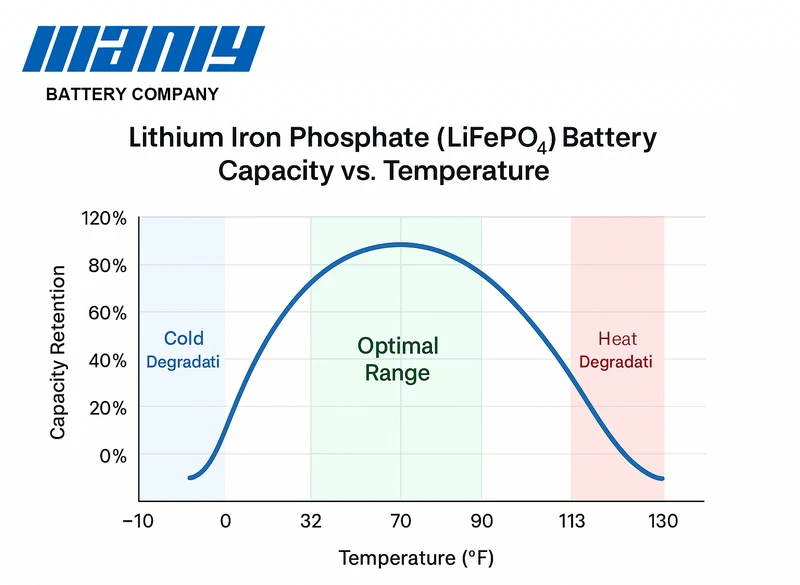
Upgrading Your RV Battery System to Lithium
Switching to lithium RV batteries is one of the smartest upgrades RV owners can make today. This section helps you weigh the investment, understand how to select the right battery manufacturer, and see why a china battery factory often delivers the best combination of price, quality, and innovation.
1. Is Switching to Lithium Worth It?
Yes—and here’s why. While lithium RV batteries typically have a higher upfront cost than lead-acid options, they make up for it with longer lifespan, lighter weight, and zero maintenance.
Most quality lithium batteries last 10–15 years and offer 3,000 to 5,000 full charge cycles, compared to just 500 cycles for traditional flooded or AGM batteries. Over time, that difference translates into fewer replacements, lower total cost of ownership, and better reliability during off-grid adventures.
Key benefits include:
- 50% less weight than lead-acid, improving overall RV efficiency.
- Faster charging, cutting downtime between uses.
- No maintenance—no fluids to refill, no corrosion to clean.
- Stable LiFePO₄ chemistry, which resists overheating and performs well across a wide temperature range.
If you travel often, enjoy boondocking, or rely on solar power, upgrading to lithium ensures dependable performance for the long haul.
2. Working with a Reliable Battery Manufacturer
Not all lithium batteries meet the same standard. To avoid issues with lifespan, safety, or warranty support, it’s critical to source from a trusted battery manufacturer with a solid reputation and track record.
Here’s what to look for:
- Certifications: Look for UN38.3, UL, CE, or IEC safety and compliance marks.
- Technical transparency: Reliable manufacturers offer detailed spec sheets, including battery management system (BMS) capabilities, voltage windows, and rated cycle life.
- Support and documentation: Make sure they provide product manuals, installation guides, and customer service options.
- Proven track record: Ask about their export history, production capacity, and customer references.
If you plan to find a manufacturer outside the U.S., be sure they understand international shipping logistics and can handle proper packaging, customs documentation, and after-sales service.
3. Why Many Choose a China Battery Factory
Over 80% of the world’s lithium batteries come from China. That’s not a coincidence—it’s the result of focused investment, economies of scale, and advanced manufacturing. A china 12v lifepo4 lithium battery factory often delivers the ideal balance of performance and affordability.
Advantages include:
- Lower cost per kWh: Chinese factories reduce cost through vertical integration and large-scale output.
- Advanced battery features: Many offer Bluetooth monitoring, self-heating functions, and built-in diagnostics.
- Bulk order flexibility: Whether you’re outfitting a fleet or reselling batteries, factories in China can fulfill large and customized orders.
- Private labeling: Need your own brand name on the battery? Most factories offer OEM and ODM services for business customers.
From off-grid RVers to solar equipment installers, global buyers increasingly look to China for reliable, well-supported lithium solutions.
How to Find a Manufacturer for Lithium RV Batteries
If you’re looking to upgrade your RV’s power system or planning to import batteries for resale, choosing the right battery manufacturer matters more than ever. This section walks you through how to find a manufacturer that delivers reliable lithium RV batteries, tailored to your needs, timeline, and budget. Whether you’re searching for a domestic supplier or a trusted china battery factory, you’ll learn what to check before you commit.
1. Research, Compare, Verify
Begin with online directories like Alibaba, Global Sources, and ThomasNet. Use filters to find suppliers focused on LiFePO₄ chemistry and sort by certification (UL, CE, UN38.3), voltage (such as 12V), and production capability. If your goal is to source from a china 12v lifepo4 lithium battery factory, check for export experience, safety compliance, and factory audits.
Once you have a shortlist, verify:
- Their business license and factory registration
- Technical datasheets with performance specs
- Certifications for transport and safety (e.g., MSDS, UN38.3)
- Verified customer reviews or B2B case studies
Avoid suppliers who hesitate to provide documentation. Transparency and consistency are key in the lithium battery space.
2. Request Samples and Quotes
Before moving forward, request:
- Product samples to validate specs and build quality
- Detailed quotes outlining MOQ, per-unit price, and lead time
- Incoterms (FOB, CIF, or DDP) and breakdown of shipping options
- Warranty coverage, payment terms, and return policy
A qualified battery manufacturer will include engineering support, offer performance test results, and respond quickly to your requests. Be sure to confirm whether quotes include customs clearance costs when importing from a china battery factory.
3. Domestic vs. Overseas Sourcing
Choosing between U.S.-based and international manufacturers depends on your business goals:
Domestic sourcing benefits:
- Shorter lead times and lower shipping risk
- Easier communication and time zone alignment
- Legal safeguards under U.S. law
Overseas sourcing, especially from a china 12v lifepo4 lithium battery factory, offers:
- Significantly lower per-unit pricing
- Mature supply chain and high-volume capacity
- Access to the latest innovations in battery tech
However, overseas sourcing may involve:
- Longer production and shipping lead times
- Language or cultural barriers
- Import duties and potential delays at customs
Still, many U.S. businesses prefer working with a china battery factory due to flexibility in bulk orders, custom features, and scalable pricing.
4. Questions to Ask When You Find a Manufacturer
Before you finalize your supplier, ask these key questions:
- What international certifications do your lithium RV batteries meet (UL, UN38.3, CE)?
- What’s the rated cycle life and calendar life of your products?
- Can you support OEM or private label customization?
- How do you handle post-sale support and warranty claims?
- Are your battery management systems (BMS) customizable?
- What is the average turnaround time for repeat orders?
- Do you provide U.S.-based technical support or warehousing?
The answers will tell you a lot about the supplier’s reliability and whether they’re equipped to meet long-term demands.
Conclusion
Lithium RV batteries offer unmatched longevity and efficiency—often lasting a decade or more with proper care. But not all batteries are created equal. From storage habits to charging practices, and especially the quality of the battery manufacturer, each factor plays a key role in how well your battery performs over time. If you’re ready to upgrade or need to find a manufacturer for reliable, certified lithium solutions, take the time to research and verify before buying. A well-chosen battery means fewer replacements, less stress on the road, and more freedom wherever your RV takes you.
FAQ
1. Are lithium batteries worth it for RV?
Yes, lithium RV batteries are absolutely worth the investment for most RV owners. While they cost more upfront than lead-acid batteries, they last much longer (10–15 years), charge faster, weigh less, and require zero maintenance. Over time, they reduce replacement costs and improve reliability—especially if you camp off-grid or use solar power.
2. Do lithium batteries really last 10 years?
Yes, high-quality lithium batteries—especially LiFePO₄ types—can last 10 years or more with proper use and storage. Many are rated for 3,000 to 5,000 charge cycles, which is significantly more than traditional batteries. Lifespan depends on usage habits, temperature control, and choosing a reputable battery manufacturer.
3. What is the 80 20 rule for lithium batteries?
The 80/20 rule means you should keep your lithium battery charged between 20% and 80% for daily use to extend its cycle life. While lithium batteries can safely discharge to near 0% or charge to 100%, avoiding those extremes reduces long-term chemical stress and helps the battery last longer.

